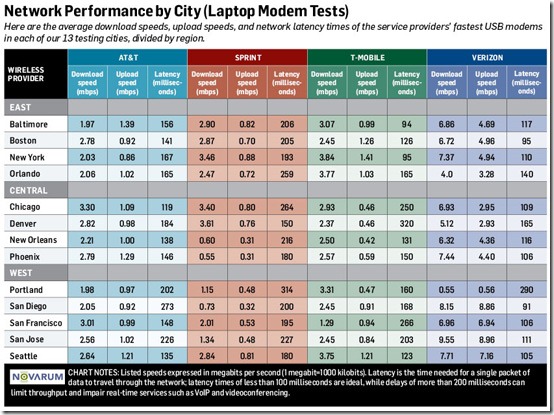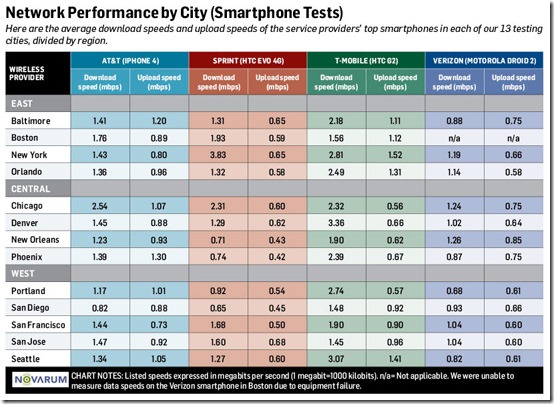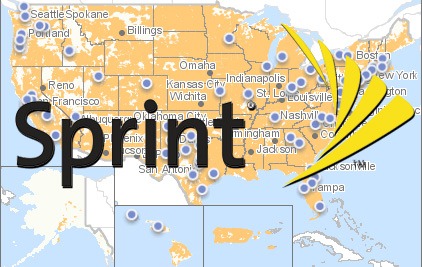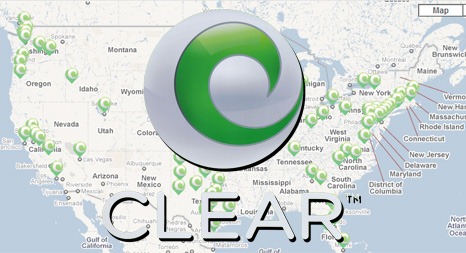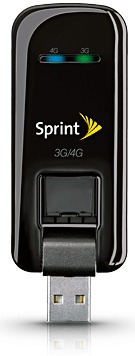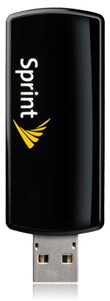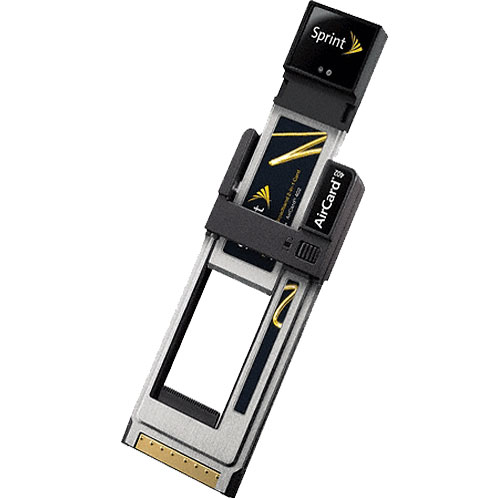
4G Unlimited Mobile Broadband in 82 Cities
This Review Is Dated. Please See The 2012 Sprint 4G Review.
Contents: Plans Speed Coverage Devices Summary
The fundamentals of Sprint 4G mobile broadband haven’t changed since last year’s review.
What has changed is 4G coverage availability in a total of 82 cities, 3 new 4G mobile broadband devices and even talks of leaving WiMAX in favor of LTE.
With multiple changes on the table, a lot is happening now for the “Now Network”. As always, this review will be split into 4 detailed sections:
- Sprint 4G Plans
- Sprint 4G Speed
- Sprint 4G Coverage
- Sprint 4G Broadband Cards & Mobile Hotspots
Sprint 3G & 4G Plans
6 Plans. 2 Come With Unlimited Mobile Broadband.

Since their 2010 Sprint 4G plans review, they’ve added 4 mobile broadband plans. Like AT&T 4G plans, they’re categorized based on the device you’ll be using to access them.
Unlike AT&T and most other carriers, the feather in the cap for Sprint 4G plans is this:
Unlimited mobile broadband.
While their 3G plans aren’t, the overage charges are on par with the competition.
What Sprint Advertises:
| Mobile Broadband Plans | Price | Data | Overage Charges |
| 4G Plan | $49.99 | 4G: Unlimited | None |
| 4G/3G Plan | $59.99 | 4G: Unlimited | 3G: 5 GB/300 MB (roaming) | 4G: None | 3G: 0.05/MB or $51.20/GB |
| 3G Plan | $59.99 | 5 GB/300 MB (roaming) | 3G: 0.05/MB or $51.20/GB |
| Dell™ Inspiron™ 11z and Dell™ Inspiron™ Mini 10 (1012) 3G Plan | $39.99 | 500 MB | 3G: 0.05/MB or $51.20/GB |
| Tablet 3G Plan (5 GB) | $59.99 | 5 GB | 3G: 0.05/MB or $51.20/GB |
| Tablet 3G Plan (2 GB) | $29.99 | 2 GB | 3G: 0.05/MB or $51.20/GB |
If you’re confused by the 300 MB vs. 500 MB vs. 2 GB vs. 5 GB data plan amounts, then you run the risk of overpaying for too much data you don’t need or overage charges if the data package you purchased was too small.
An uninformed customer is a higher paying customer.
You can help fix that by doing one of two things:
- See “How Much is 5 GB & Is It Enough?”.
- See Sprint’s “How Much Data Do You Use?” for examples of what you can do with 500 MB, 1 GB, 2 GB and 5 GB.
General Mobile Broadband Plans (3G, 4G and 3G/4G Plans)
Sprint’s ‘strictly’ 4G mobile broadband plan will run you $50 per month.
This is can work out great if you live in or travel only to major cities where Sprint 4G coverage is available.
However, if you travel off the beaten path like myself, you’ll want to opt for the Sprint 3G/4G plan for $10 extra. That way, you’ll have 3G coverage and data where 4G isn’t available.
With that being said…
It makes absolutely no sense to get the strictly 3G plan for $60 each month. You pay the same amount as the hybrid 3G/4G plan but don’t get unlimited mobile broadband.
Even if 4G coverage isn’t available in your area, it makes sense to get it in the event that it does get to you or if you ever travel to an area that does.
Dell™ Inspiron™ 11z and Dell™ Inspiron™ Mini 10 (1012) 3G Plan
The Dell 3G plans run $40 per month for 500 MB of data.
Don’t get this plan.
If you do, you’ll be paying 33% less money for approximately 1000% less data than the regular 5 GB 3G plan.
That’s an incredibly bad ratio for you and incredibly profitable for them. Even if you don’t use even half of 500 MB per month, you’d be better off going with a prepaid mobile broadband solution.
That way, even if you use the same amount, you wouldn’t be locked into a contract.
Tablet 3G Plans
Like AT&T, Sprint provides special pricing for tablets.
At the 2 GB level, Sprint’s plan ends up being $5 more expensive. However, at the 5 GB level, AT&T ends up costing you $5 more.
The true difference between the two sets of plans are overage charges. AT&T’s overages are $10/GB while Sprint’s overages are $51.20/GB. If considering a mobile broadband provider for tablets including the iPad, you may want to consider AT&T especially if you use larger amounts of data.
Back To Top
Sprint 4G Speed
WiMAX with LTE on the Way?
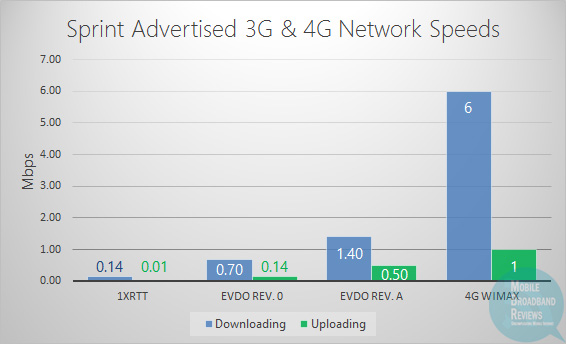
This chart shows the upper limits of each range for average speeds (not maximum speeds)
Since last year, Sprint mobile broadband speeds (3G & 4G collectively) have increased 170%. Here’s the kicker though, neither Sprint or any carrier actually has 4G speed:
Like mobile broadband, the definition of 4G changes based on who you ask.
The International Telecommunications Union Radiocommunication Sector (ITU-R, say that three times fast), defines 4G as “a cellular system that must have target peak data rates of up to approximately 100 Mbps for a high mobility connection (read: mobile broadband) and 1 Gbps for low mobility (think: wireless Clear 4G modems that don’t move too much).
With that being said, no U.S. provider offers true 4G service.
Sprint advertises 3-6 Mbps downloading with bursts up to 10 Mbps along with up to 1 Mbps uploading. While that’s definitely faster than their advertised 3G speeds (0.6 Mbps – 1.4 Mbps down and 0.3 – 0.5 uploading) it’s not exactly 100 Mbps.
On the other hand, it is much faster relative to their 3G speeds.
What Kind Of 3G & 4G Speeds Will You Actually Get?
Brian Nadel of Computerworld.com pitted Sprint’s 4G speed against its 3G speed. Here’s what he found:
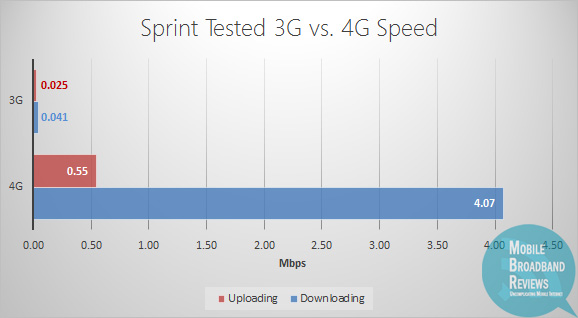
First, the good news: It’s fast. Really fast.
The 4G network delivered an average download speed of 4.1Mbit/sec. — about what you’ll get with a wired DSL or cable modem connection. It was seven times faster than Sprint’s 3G service, which averaged 550Kbit/sec. I received a peak 4G download speed of 11.2Mbit/sec. at one location, nearly 10 times faster than the 1.2Mbit/sec. of throughput available on Sprint’s 3G network at the same location two minutes later.
Now for the bad news: I found uploading data painfully slow on both services. While 3G mustered a 25Kbit/sec. throughput from notebook to server, 4G was able to move 41Kbit/sec. — not a terribly significant improvement. Clearly, this service is more useful for downloading large chunks of data, such as monster spreadsheets, videos and presentations, than for tasks such as uploading content to a Web site or sending e-mails bulging with attachments.
While this is representative of the general difference between Sprint 3G and 4G speeds, the speeds you’ll get can vary widely from city to city.
That’s where PCWorld.com comes in.
Laptop & Smartphone 4G Speeds By City
The charts below list the cities in the leftmost column; moving rightward across the chart, you can see the speed averages and network latency times for each of the four wireless networks.
Speeds are expressed in megabits per second (mbps). Latency (or the time it takes a single small packet of data to travel to a network server and back) is represented in milliseconds. We recorded download and upload speeds and latency times during our laptop-modem tests, and download and upload speeds in our smartphone tests.
– PCWorld.com
With regards to Sprint 4G speeds, its important to note that the city-by-city tests weren’t chosen based on where 4G was available. Rather, they were selected to be consistent with previous tests.
As a result, not all cities tested had 4G speeds. When 4G was not available, 3G speeds were tested.
Use the charts below as a 4G speed reference guide only if Sprint 4G coverage was available in the city tested.
Clicking on the images below will take you to PCWorld’s enlarged versions.
Sprint 4G LTE and 4G WiMAX Together?
While Sprint had beaten everyone to the 4G punch 2 years ago, they run the risk of falling behind.
While other carriers have been aggressively expanding speed and coverage, Sprint’s 4G network isn’t seeing the aggressive expansion it saw last year. While they say nationwide 4G coverage will happen within 2 years, financial issues with their WiMAX partner Clear (Clearwire) may be slowing down progress.
The solution?
The answer might be to build an LTE network that would complement the existing Clearwire WiMAX network. The phones connected to that network would need to be tri-band, meaning that they will contain new CDMA chipsets that also support LTE, with a WiMAX radio “velcroed on.” The fact that Sprint is even talking about such tri-band radios for it phones is proof that it’s serious about LTE.
How soon would it happen? According to a Sprint executive, the decision to transition from WiMAX to LTE could be made this year.
Bottom-Line on Sprint 4G Speeds
Sprint’s 4G network is definitely faster than 3G.
While it’s not nearly as fast as Verizon’s 4G LTE, it’s more than enough for most people. Furthermore, since they’re the only truly unlimited mobile broadband provider of the bunch, that servers as a serious competitive advantage if you’re looking for a cable or DSL replacement.
For now, their 4G speed is still competitive but is losing ground to the upgrades of T-Mobile, AT&T and Verizon. In addition to increasing speeds in the future, they’ll need to expand 4G coverage to many more places.
Sprint 4G Coverage
82 Cities. Expansion Stalled.
The Sprint 4G coverage game plan last year was to cover 80 markets by the end of 2010. However, at 4 months into 2011, the Sprint 4G cities list count is 82.
With over a quarter of the year already past and only 2 cities worth of 4G coverage growth past 2010 goals, things aren’t looking optimistic.
The source of the problem?
It appears to be their 4G WiMAX partner Clearwire (marketed as Clear):
Clearwire is having serious money problems and will need to find a cash infusion to keep going past the near-term.
Why doesn’t Sprint just give Clearwire the cash it needs to expand the WiMAX network rapidly?
The theory goes that Sprint and Clearwire are in a struggle for control of the network, with Clearwire not relinquishing enough control to warrant a cash infusion from Sprint.
While this is all going on, Sprint’s 4G network expansion appears to be on hold. Clearwire has enough money to “maintain” its current network. But expansion into new cities has slowed to a trickle.
Checking Sprint 4G Coverage In Your City
There are two ways to see 4G (and 3G) coverage in your city:
If looking at strictly 4G coverage, Clear’s coverage viewer is much more user friendly thanks to 4G coverage overlay on a Google map. While you can also see 3G coverage using their tool, the shading of green makes it more difficult to see.
However, since they display only 3G and 4G coverage, there’s no potential confusion for 2G dialup like speed coverage being mixed in with mobile broadband coverage as AT&T does here.
If looking at strictly 3G coverage, Sprint’s tool cuts right to the chase with a clear street, state and country level view of nationwide coverage. 4G coverage is equally visible, but isn’t as aesthetically pleasing as Clear’s.
Either way, you’ll find the information you need. Click on any of the coverage maps below to open Sprint & Clear’s tools respectively in new windows:
The Bottom-Line On Sprint 4G Coverage
Whether or not Sprint will continue building out 4G coverage for a nationwide footprint in 2013 remains to be seen.
By the end of this year, they’ll make a decision on whether or not to transition from WiMAX to LTE. For now, Sprint 4G is still a strong offering where 4G coverage is available.
However, if you’re outside the coverage area, you may want to hold off on buying a 3G/4G hybrid device in hopes of being prepared for when it arrives to your area.
It’s better to wait until they make a decision on LTE. That way, if they do go the LTE route, you can purchase a WiMAX/LTE hybrid device that would support their current 3G network as well as 4G WiMAX and LTE networks.
Back To Top
Sprint 3G & 4G Devices
4 USB Modems, 2 Mobile Hotspots & 1 ExpressCards

Since last year, Sprint has added 2 new 4G broadband cards and 2 new mobile hotspota while shelving 5 devices for a revamped mobile broadband device line.
I’ll cover Sprint’s 4G and 3G devices in 3 categories before wrapping up with why you can ignore all but 2 devices:
- Sprint USB Broadband Cards
- Sprint Mobile Hotspots
- Sprint ExpressCards & PC Cards
Sprint USB Broadband Cards
New to the Sprint 4G broadband card mix are the U600 and the U1901 (pictured from left to right in the table below).
Since the U1901 is a 4G-only device and Sprint 4G coverage is still limited, you’ll want to take a look at the U600 which runs on both their 3G & 4G networks plus have a many more features (multiple antenna ports for better regular reception and GPS reception). Did I mention it’s also free?
While the 598U and U760 are still going on strong with their respective feature sets, they’re several years old and aren’t 4G capable.
Since Sprint’s 4G plans cost the same whether you’ve got only 3G or 3G & 4G, you’ve got nothing to lose and everything to gain from a device that can access the faster 4G speeds even if it’s not in your area yet.
Retired Models:
Sprint Mobile Hotspots
Sprint’s done away with its infamous MiFi 2200 and Sierra Overdrive in favor of its successor, the Sierra Overdrive Pro and the Novatel 4G MiFi.
The major advantages the Pro has over its predecessor are a larger screen, smaller size, WiFi-sharing for 8 instead of 5 devices, a doubled 32 GB microSD storage capacity plus a 4G WiMAX dock that can boost reception up to 50%.
While it runs $20 more than the Overdrive did, it’s small price to pay for the extra features.
In Novatel’s corner, the 4G WiMAX MiFi retains its smaller form factor and acts as the first 4G answer to Sierra’s improved Overdrive.
|
Sprint Mobile Hotspot |
 |
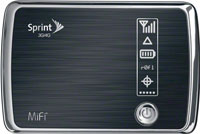 |
|
Full Review |
Sierra Overdrive Pro 3G/4G Mobile Hotspot |
Novatel 3G/4G MiFi Mobile Hotspot |
|
Video Review |
N/A |
N/A |
|
Form Factor |
Mobile Hotspot |
Mobile Hotspot |
|
External Antenna Jack |
No |
No |
|
Max Download Speed Potential |
Up to 10 Mbps via 4G / Up to 3.1 Mbps via 3G |
Up to 10 Mbps via 4G / Up to 3.1 Mbps via 3G |
|
OS Compatibility |
Anything that works via WiFi (computers, phones, game consoles, etc) |
Anything that works via WiFi (computers, phones, game consoles, etc) |
|
Network Compatibility |
Sprint 3G / 4G Network (EVDO Rev. A / WiMAX) |
Sprint 3G / 4G Network (EVDO Rev. A / WiMAX) |
|
GPS |
Yes (when in 3G mode) |
Yes (when in 3G mode) |
|
Extra Storage |
microSD (up to 32 GB) & is shared via WiFi with any connected device |
microSD (up to 32 GB) & is shared via WiFi with any connected device |
|
Support Info |
Yes |
Yes |
|
Price |
$60 on the spot |
$80 from Sprint |
Retired Models:
- Sierra Overdrive (1st edition)
Sprint ExpressCards & PC Cards
Returning for yet another year is the Sierra Wireless AirCard 402.
Most likely kept on-board for users that have older equipment, the AirCard 402 runs light on features but still gets you online.
Which Device Should You Get?
If you’re in the market for a broadband card, the device of choice is the Sprint U600. With 3G/4G capability, 4 antenna ports for better reception with 3G, 4G and even GPS, compatibility with Windows, Mac and Linux plus a very small form factor, the only thing missing is a microSD slot.
If you’re in the market for a mobile hotspot, the Overdrive Pro improves in many places where the Overdrive left off. Its smaller, boots up faster, has a bigger screen, a dock to improve reception (sold separately) and dual external antenna ports.
Presumably, they’ve fixed the major issues of battery swelling and connectivity drops that the original Overdrive had.
Since the device is brand new, more time will have to pass for feedback to come in from users after putting their new devices through real world stress tests.
Get The Sierra Overdrive Pro Here
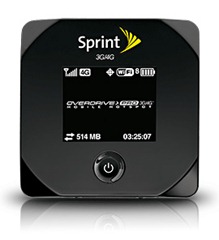
Get The Sprint U600 For Free Here
Summary
So Does Sprint Mobile Broadband Make The Cut?
Whether Sprint makes the cut has just as much to do with broadband cards as it does 3G/4G plans, speed and coverage. Here’s a brief recap:
Sprint Plans
Out of AT&T, T-Mobile & Verizon, Sprint 4G plans are the only truly unlimited mobile broadband plans being offered by any of the major providers.
Plans specific to tablets and netbooks are also available but aren’t unlimited since they operate on the Sprint 3G network.
Sprint 3G & 4G Speed
Sprint 4G speed is advertised as up to 10 times faster than 3G. Speed tests show its more like 3-5 times faster. However, since last year Sprint mobile broadband speeds (3G & 4G collectively) have increased 170%.
Sprint 3G / 4G Coverage
The Sprint 4G coverage game plan last year was to cover 80 markets by the end of 2010. However, at 4 months into 2011, the Sprint 4G cities list count is 82.
With over a quarter of the year already past and only 2 cities worth of 4G coverage growth past 2010 goals, things aren’t looking optimistic.
By the end of this year, they’ll make a decision on whether or not to transition from WiMAX to LTE.
Sprint Broadband Cards & Personal Hotspots
Since last year, Sprint has added 2 new 4G broadband cards and 1 new mobile hotspot while shelving 5 devices for a revamped mobile broadband device line.
Out of the 6 Sprint 4G broadband cards & mobile hotspots available, you’ll want to get your hands on the Overdrive Pro or U600.
Not Sure About Sprint? Check out our Postpaid Mobile Broadband Comparison
Back To Top

